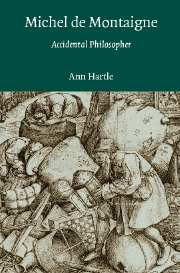Book contents
- Frontmatter
- Contents
- Acknowledgments
- Note on the Texts
- Introduction
- PART I A NEW FIGURE
- 1 “That Is Where He Got It!”: Montaigne's Caprices and the Humors of Ancient Philosophy
- 2 Bending and Stretching the Categories of Traditional Metaphysics
- 3 The Essay as Philosophical Form
- PART II ACCIDENTAL PHILOSOPHY
- PART III THE CHARACTER OF THE ACCIDENTAL PHILOSOPHER
- Notes
- Works Cited
- Index
3 - The Essay as Philosophical Form
Published online by Cambridge University Press: 23 July 2009
- Frontmatter
- Contents
- Acknowledgments
- Note on the Texts
- Introduction
- PART I A NEW FIGURE
- 1 “That Is Where He Got It!”: Montaigne's Caprices and the Humors of Ancient Philosophy
- 2 Bending and Stretching the Categories of Traditional Metaphysics
- 3 The Essay as Philosophical Form
- PART II ACCIDENTAL PHILOSOPHY
- PART III THE CHARACTER OF THE ACCIDENTAL PHILOSOPHER
- Notes
- Works Cited
- Index
Summary
In The Age of Cathedrals, Georges Duby traces out the conditions and causes that ultimately brought into being the great Gothic cathedrals of France. The economic and social conditions were right, of course, but the true cause was theological. The abbot of Saint-Denis, Suger, pushed forward the transformation from monastery to cathedral in an attempt to express his belief that God is Light. This is especially evident in the choir of Suger's new church: here “the mutation in aesthetics took place … at the culmination of the liturgical procession turned toward the rising sun.” At that point, Suger “decided to take away the walls and urged the master builder to make fullest use of the architectonic resources of what until then had been merely a mason's expedient, the ribbed vault.” Duby's account reveals that the creation of a new art form is not essentially the result merely of technical advances. The cathedrals do not come into being simply because the art of architecture now has the wherewithal to construct buildings of such great height, with walls of stained glass. Indeed, the very impetus for the architectural developments comes from outside the art. The master builders are urged on by the demands of faith to transform the mere mason's expedient, the ribbed vault, into “the glowing center” where the liturgical celebration takes place. Suger “revolutionized accepted notions of architecture by transforming an edifice into the tangible demonstration of a theology of light.”
- Type
- Chapter
- Information
- Michel de MontaigneAccidental Philosopher, pp. 62 - 88Publisher: Cambridge University PressPrint publication year: 2003

